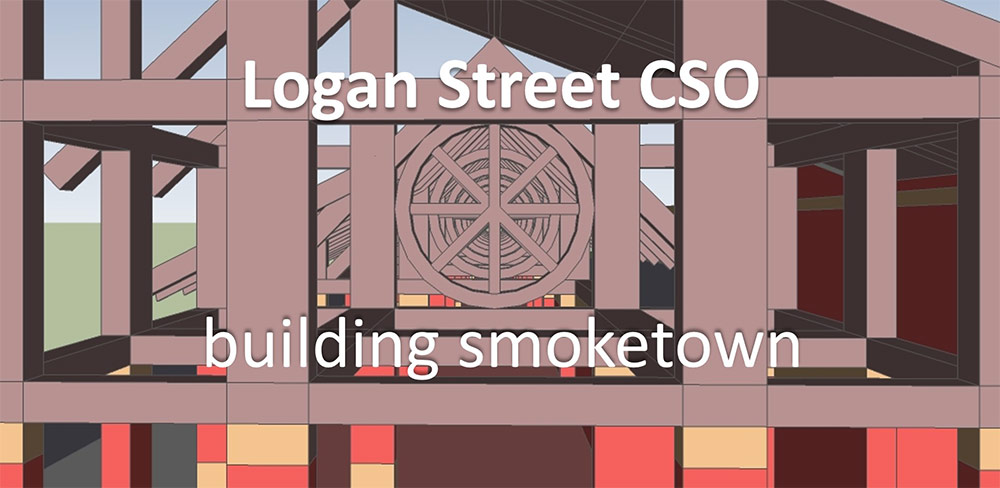[Editor’s Note: Earlier today, Elijah McKenzie explained how MSD is combating combined sewer overflows in Louisville with a combination of green and gray infrastructure. One of those gray projects is a large CSO Basin on Logan Street in Smoketown that presents an ugly face to the neighborhood. Here, urban planner Nick Seivers proposes simple design interventions to dress up MSD’s plan. The post originally appeared on Seivers’ blog, Urban Composition, where he re-imagines various sites around the city. He has been a regular contributor to Broken Sidewalk.]
At the Shelby Park Germantown Rail Corridor meeting in July, representatives of the Metropolitan Sewer District (MSD) introduced the Combined Sewer Overflow (CSO) solution for a recently cleared site on Logan Street, southeast of the Breckenridge Street intersection in Smoketown.
The planning and engineering phases, cost-benefit analysis, and discussions with federal agencies are all complete (3MB pdf). The design of the Logan Street CSO will not be reopened or revisited—except to dress it up a little bit. MSD has some money in reserve to break up the massing of the aboveground portion of the detainment basin.

Some outrage over the lack outreach was expressed at the Shelby Park Germantown Rail Corridor Meeting, particularly by a spokesperson of the recently organized I.D.E.A.S. 40203 which received grants for creating public art in the area. That group would like to activate the boring expanse of wall on Logan and Breckenridge streets proposed by engineers for MSD. I and MSD agree with this concept.
Executing this concept in a way to build up and support everyday street life, community building events, and showcasing artwork within the limited budget of a governmental entity is an entirely different discussion. We have all seen faux storefronts on big box stores and parking garages. And we have all seen artists airdrop art on disadvantaged neighborhoods. I believe both efforts to be well intentioned but lacking in authenticity and impact.

So let’s maximize the green—sustainable infrastructure and return on dollars spent.
Here’s what we know: Breckenridge Street runs one-way going west. Logan Street runs one-way going north. Beargrass Creek—of which the CSO structure will intercept sewerage prior to overflow—is channelized. The CSO structure will have nearly 500 feet of uninterrupted wall on Logan Street and parking and loading on Breckenridge Street. A double-buffered bike lane has recently been striped on Breckenridge. A bus line operates on Logan. Beargrass Creek will remain channelized here. Of the two streets, I would say Breckenridge carries more traffic. Logan Street is more residential in nature.

So, what if we concentrated the human activity at the corner of Breckenridge and Logan streets? Build a nice bus shelter that could double a space for special events on Logan and Breckenridge streets. On Logan, from Breckenridge southward, interventions include the bus shelter, a space for seating and sculptural installations, a playground, and then bioswales. Brightly-colored, whimsical murals should be painted on the long wall. The vegetation and tree groupings would increase in intensity farther south on Logan Street from the Breckenridge intersection across from the rows of shotgun-style homes.

On Breckenridge, from Logan eastwards, the streetscape would include the bus shelter, then a bike repair station, and a green-roofed arcade that could house additional artwork, and, during festivals, farmers market tents and craft vendors. These spaces could be used any day of the week for small businesses—an affordable, temporary, start up space, that activates the street, and energizes this corner between the Highlands and Old Louisville, in Smoketown.





Nice improvement concepts. Also, how about an overlook walking path along the nonroadway side perimeters overlooking creek and back to Logan street. Give the public a bit of view of the creek, even if it is channeled in this section. Because the creek is nearly invisible in this are due to the channel being under or adjacent to the railroad line.
Lets not abdicate our role as informed citizens to point out the fundamental flaws in MSD’s approach to controlling sewer overflows in Louisville. Your blog demonstrates profound knowledge of the planning and zoning and Louisville infrastructure procedure, yet like most other news sources, it dares not make the connection between the millions of dollars of public funds to be expended and the happy recipients of those funds in the major engineering firms and concrete suppliers. Building big basins is big time corruption and big time failure of Metro Council to do its job and pass a green infrastructure ordinance. Its poor design efficiency at the least to fail to require retrofits of major parking lots like Mid City Mall that discharge to the CSS. A retro fit ordinance could reduce the size or eliminate the need for the Logan Street basin while at the same time increasing tree canopy and recharging ground water. Instead we have baking asphalt.
Another asphaltic gaff (and they want to do this along BareGrass creek and deforest the entire area) to match the sidewalk disaster on Story Ave. ADA anyone ??
I contacted the Mayors right hand guy about retention of the buildings that were lively little one story Art Deco babies with potential written all over them. I got zero response – well I guess their demolition was the response . Now they want to dress up stupid in more Emperors new clothes when they coulda done something green contextual and urban. This city throws more possibility into the sewers than rainwater has time to puddle. It coulda been an urban dog park or or or. Heat Usland City being subsidized by our tax dollars. And again, please explain Story Ave sidewalks that aren’t . And in front if the Eye Institute no less. Sigh.
Between the “every big project is a boondoggle” crowd and the “every building that’s ever been built is worth saving crowd” this city will waste away or be completely washed away in a flood of sewage. While I am 100% in support of limiting the size of the basin through green infrastructure projects – and were I a member of the neighborhood I would look at this idea totally cockeyed – the fact remains that there is enough runoff in the area that a basin seems unavoidable. Additionally there are money and time constraints (i.e. consent decree with the federal government) that also make a basin a worthy solution to what is serious health issue.
For all of its communicative failures, MSD has done a pretty remarkable job of negotiating with the EPA in regards to CSOs and is achieving solutions at significantly better costs and with way less concrete than most cities. We could be doing billion dollar holes in the ground like Cincinnati or Philly. There is absolutely room for improvement and MSD needs to make sure they’re thinking about how their projects integrate into the urban culture, but lord almighty, the idea that “This city throws more possibility into the sewers than rainwater has time to puddle,” is alarmingly blind to A.) the problem at hand, which is serious and in some parts of the city actually deadly! and B.) Totally myopic in the scope of what preservation should be about.
Full disclosure: I have relatives at MSD who, depending on the day, I agree with.
Also Bud, I quite appreciate your site and insights even if I just totally and pejoratively lumped you in with the boondoggle crowd.